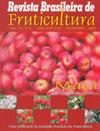南巴西大州桃金娘属植物(O. BERG) D. Legrand)锈病的发生
IF 0.9
4区 农林科学
Q4 HORTICULTURE
引用次数: 2
摘要
番石榴树(Myrcianthes pungens)属于桃金娘科,广泛分布于巴西南部的巴西格兰德州(RS),其新鲜果实具有甜味,除了具有营养保健特性外,还可用于饮料、果冻和冰淇淋,因此具有巨大的商业潜力。锈病的主要特征是在受累器官上形成橙色脓疱,其中含有病原体的脲嘧啶孢子。病原菌的作用引起茎、叶、花和果实的变形,从而干扰植物的生理过程。因此,本研究的目的是在报告巴西南埃尔多拉多州瓜比菊工作采收中对桃锈病最敏感和最抗性的品种的基础上,提供有关瓜比菊锈病发生和病原确认的信息。该病的诊断是基于症状、光镜观察真菌结构和分子分析。镜检结果显示,孢子呈椭圆形到卵形,略呈扁圆形,具有桃孢的特征。该菌株的内部转录间隔区(ITS)序列与基因库GenBank (NCBI)中psidii的相同区域序列相似度为99.06%。这是巴西南巴西大德州首次报道与瓜比菊有关的锈病。根据所建立的图解尺度,可以确定所研究的番石榴种质对psidii的不同敏感程度。本文章由计算机程序翻译,如有差异,请以英文原文为准。
Occurrence of Rust in Myrcianthes pungens (O. BERG) D. Legrand Caused by Austropuccinia psidii in The State of Rio Grande do Sul
Abstract Guabiju tree (Myrcianthes pungens) belongs to the Myrtaceae family, with wide occurrence in Rio Grande do Sul (RS), southern Brazil, demonstrates great commercial potential regarding the consumption of its fresh fruit, which has a sweet taste and can be used in drinks, jellies and ice creams, in addition to its nutraceutical properties. As their main characteristic, rusts present the formation of orange pustules containing urediniospores of the pathogen on affected organs. The action of the pathogen causes deformation of stems, leaves, flowers and fruits, thus interfer-ing with the physiological processes of the plant. Thus, the present work aimed at presenting information on the occurrence and confirmation of the causal agent of guabiju rust, in addition to reporting the accessions most susceptible and resistant to Austropuccinia in the guabiju working collection of Eldorado do Sul, RS, Brazil. The diagnosis of the disease was based on symptoms, observation of fungal structures by light microscopy and molecular analyses. From microscopy, ellipsoid to ovoid and slightly equinulate urediniospores were observed, characteristic of Austropuccinia sp. The sequence of the internal transcribed spacer (ITS) region of the isolate showed 99.06% similarity with sequences from the same region of A. psidii deposited on the nucleotide database - GenBank (NCBI). This is the first report of rust associated with guabiju in the state of Rio Grande do Sul, Brazil. From the diagrammatic scale developed, it was possible to identify different levels of susceptibility to A. psidii in guabiju accessions under study.
求助全文
通过发布文献求助,成功后即可免费获取论文全文。
去求助
来源期刊
CiteScore
1.50
自引率
20.00%
发文量
34
审稿时长
4-8 weeks
期刊介绍:
The Revista Brasileira de Fruticultura (RBF) publishes technical articles and scientific communications in the area of fruit crops, referring to results of original searches and unpublished papers in Portuguese, Spanish or English, and 1 or 2 reviews per edition, of invited authors.

 求助内容:
求助内容: 应助结果提醒方式:
应助结果提醒方式:


